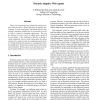Free Online Productivity Tools
i2Speak
i2Symbol
i2OCR
iTex2Img
iWeb2Print
iWeb2Shot
i2Type
iPdf2Split
iPdf2Merge
i2Bopomofo
i2Arabic
i2Style
i2Image
i2PDF
iLatex2Rtf
Sci2ools
KBSE
1999
IEEE
1999
IEEE
Towards Adaptive Web Agents
There is an increasingly large demand for software systems which are able to operate effectively in dynamic environments. In such environments, automated software engineering is extremely valuable since a system needs to evolve in order to respond to changing requirements. One way for software to evolve is for it to reflect upon a model of its own design. A key challenge in reflective evolution is credit assignment: given a model representing the design elements of a complex system, how might that system localize, identify and prioritize prospective candidates for potential modification. We describe a model-based credit assignment mechanism. We also report on an experiment on evolving the design of Mosaic 2.4, an early network browser.
Credit Assignment | Dynamic Environments | KBSE 1999 | Model-based Credit Assignment | Software Engineering |
| Added | 04 Aug 2010 |
| Updated | 04 Aug 2010 |
| Type | Conference |
| Year | 1999 |
| Where | KBSE |
| Authors | J. William Murdock, Ashok K. Goel |
Comments (0)

